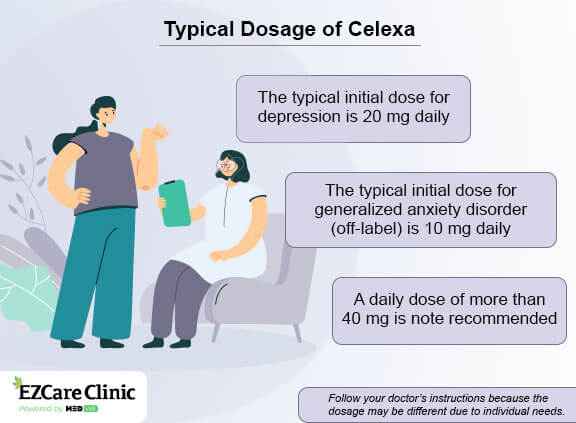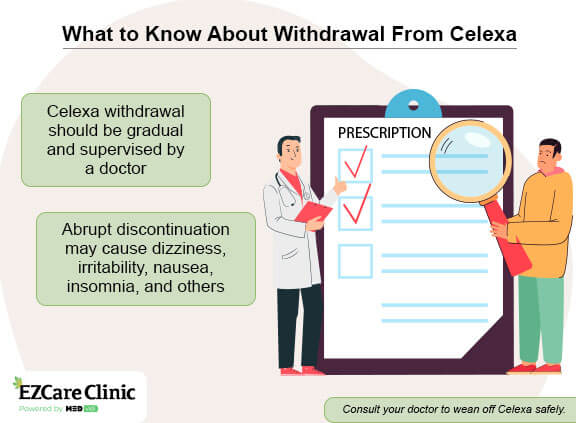The medications listed on this website are provided for informational purposes only. Their inclusion does not guarantee that they will be prescribed to any individual, as treatment decisions are ultimately at the discretion of healthcare providers. This list is not exhaustive, and healthcare providers may prescribe other medications, including non-stimulant options, based on the patient's unique health circumstances and needs.
Celexa (citalopram) is a medication widely used to treat anxiety disorders and depression in adults. It belongs to a family of drugs known as selective serotonin reuptake inhibitors (SSRIs). This drug class is known to make users feel better and help them deal with the symptoms of the named mental health disorders.
In this article, we will look at the benefits of using Celexa for anxiety, how the drug works, its dosage, and possible side effects in adults.
Consult a doctor to know what medication will help you best.
What is Celexa and How Does It Work
Celexa medication acts in the brain by suppressing serotonin reuptake, a mood-regulating hormone. Due to this mechanism of action, Celexa ensures more serotonin is available in the brain. It leads to reduced symptoms of melancholy and anxiety and improves mood. It can benefit patients who have shown resistance to other anxiety and depression medications and may also improve sleep and energy levels.
The FDA has granted approval for its use for the treatment of major depressive disorder. However, it is frequently prescribed off-label for managing anxiety disorders like
How to Use Celexa for Anxiety
Before you begin taking citalopram (Celexa), review the Medication Instructions and the Patient Information Sheet provided by the doctor. In case of concerns, feel free to seek clarification from your pharmacist or doctor.
You can take Celexa with or without food, as instructed by your doctor, generally once a day. You can choose to take it in the morning or evening. Take Celexa on a regular basis to reap the most benefits. It may take several weeks to experience the full effects of Celexa. Also, habitually take it at the same time each day so you won’t forget.
In case you miss a dose of Celexa, take it promptly when you remember. Avoid taking a double dose to compensate for the missed one.
It is crucial to take Celexa as prescribed by your doctor. Do not adjust the dose by yourself, don’t stop taking the medication abruptly, and don’t use it more frequently or for a longer period than recommended without consulting a healthcare professional.

Dosage of Celexa
Celexa dosage is typically low at first and can be progressively increased over time. It may differ from patient to patient based on the condition being addressed and the person’s specific needs. For depression, the recommended starting dose is 20 mg once daily, which may be adjusted to a limit of 40 mg daily after at least one week of treatment. On the other hand, the typical starting dose of Celexa for anxiety disorders is 10 mg once daily, which may be raised to 20 mg daily based on the type of anxiety disorder.
Patients who are over 60 years old or who have liver or kidney problems may need to start with a lower dosage, and the maximum recommended dose for these patients is 20 mg per day.
If taking the liquid formulation, precisely determine the dose with a special measuring device to ensure accuracy. You might not get the proper dose if you use a regular spoon.
If you are already taking any other medications or have preexisting mental health conditions, you should inform your doctor before they make their recommendations, since Celexa could interact with these and cause catastrophic results.
Celexa Drug Interactions
While Celexa is less likely to cause drug interactions compared to other SSRIs, it still has the potential to interact with other drugs and cause adverse effects. Some medications that may interact with Celexa are:
- Monoamine oxidase inhibitors (MAOIs). Taking Celexa along with these meds can lead to dangerous effects, including serotonin syndrome, which can be fatal. Therefore, it is essential to avoid taking Celexa within 14 days of using MAOIs such as selegiline (Emsam) and phenelzine (Nardil).
- Other SSRIs, SNRIs, and tricyclic antidepressants. Concomitant uses of drugs from similar acting classes cause major interactions. Examples of these medicines include fluoxetine (Prozac), sertraline (Zoloft), duloxetine (Cymbalta), venlafaxine (Effexor XR), and amitriptyline (Elavil).
- Nonsteroidal anti-inflammatory drugs (NSAIDs). The concurrent use of Celexa and NSAIDs, such as ibuprofen (Advil) and naproxen (Naprosyn), may heighten the risk of upper gastrointestinal bleeding.
- Anticoagulants. Celexa may increase the risk of bleeding when taken together with anticoagulants such as warfarin, aspirin, and heparin.
- Other medications. Celexa might interact with certain other medications, such as omeprazole (Prilosec), cimetidine (Tagamet), and some antibiotics including erythromycin (Eryped), and clarithromycin (Klaricid).
Get a personalized treatment plan based on your symptoms and health history.
Celexa Side Effects
Celexa, like all medications, can have side effects. The most prevalent side effects of Celexa include:
- Nausea
- Drowsiness
- Dry mouth
- Headache
- Insomnia
- Sweating
- Tremors
- Fatigue
- Abnormal heart rhythm
- Impaired concentration
- Anxiousness
It is also possible to lose or gain weight due to Celexa intake. In case of serious adverse effects, such as self-harm ideas or behavior, seek a doctor’s help immediately.
Celexa Withdrawal
If you decide to discontinue Celexa, you should do so under the supervision of your doctor. Abruptly discontinuing the drug can result in unpleasant side effects such as nausea, dizziness, irritability, and mood swings.
So, if you’ve been using Celexa for a long time, consult your doctor before discontinuing it. To alleviate symptoms of Celexa withdrawal, your doctor may advise you to reduce your dosage over a couple of weeks gradually.
Celexa and Alcohol
Celexa users should refrain from drinking. Celexa and alcohol are a bad combination; they can elevate the risk of dizziness, drowsiness, and other side effects. It can also reduce the medication’s efficacy. If you have any concerns about consuming alcohol while taking Celexa, you should consult with your doctor.
Switching to Celexa
If you do not benefit from another medication for anxiety or depression, your doctor may advise you to switch to Celexa. When switching to Celexa, the usual procedure involves gradually decreasing the previous medication dose while gradually increasing the Celexa dose to minimize the risk of withdrawal symptoms. Your doctor will determine the exact tapering schedule and doses based on your specific needs and response to the medication. When changing medications, following your doctor’s directions and reporting any variations in symptoms or side effects is critical.
Before your doctor makes any suggestions, let them know if you are pregnant or lactating. Celexa can transfer into breast milk and cause side effects in breastfeeding babies. You should also notify your doctor if you have any existing medical problems and are treating them with any medicines.

Conclusion
Celexa is a commonly prescribed medication for managing anxiety and depressive disorders in adults. Although it can be an effective medication, it’s critical to be aware of its potential side effects and to adhere to your doctor’s usage instructions strictly. If you have any concerns, book an appointment with the EZCare doctors, and they will determine how to help you.
Sources
- Treatment of generalized anxiety disorder with citalopram. (2002)
Source link - The effect of Citalopram in panic disorder. (2018)
Source link - An open trial of citalopram in adolescents with post-traumatic stress disorder. (2001)
Source link - Citalopram in the treatment of obsessive-compulsive disorder: an open pilot study. (1997)
Source link
Expert help for mental health issues.
Get treatment from licensed healthcare professionals.







